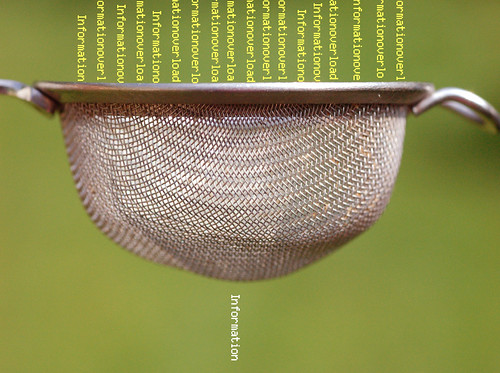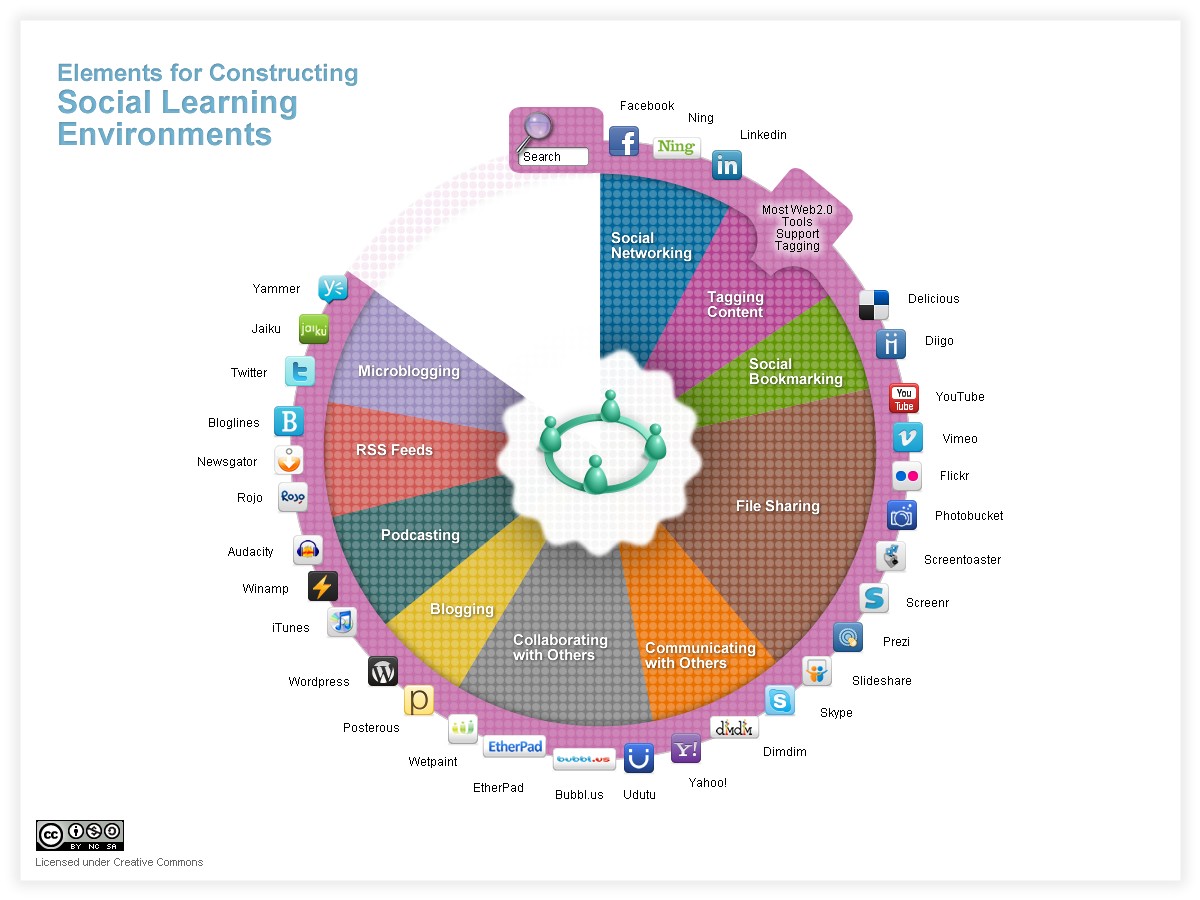Developing a conscious strategy for managing information to avoid feeling overloaded (information overload) is an important part of being a knowledge worker. While it can be said that access to web 2.0 tools such as social networking and social media contribute to information overload, I believe that they may actually enable us to organize and navigate our personal learning environments which may help us avoid information overload. Because we can customize most of our information inflows using web 2.0 tools, we have the opportunity to select the best possible channels of information. The key to doing this is through the filtering of information that we encounter in our daily lives and the curation of valuable information for sense making.
Information Overload
Do you ever feel overwhelmed by the shear wealth of information available to us? Perhaps you feel overwhelmed with the volume of information you have to process on a daily basis? Information is everywhere and in great abundance in our information age. Making sense of all of this information in order to be productive members of society throughout our daily lives can be a struggle. Frand and Lippincott (2002) suggest that the wealth of information coming at us on a daily basis can be classified under four broad themes.
Relevance: Which information available to us is most relevant for our context? When you switch on your computer in the morning you have access to more information than any culture has ever had before. Do you check your email, explore the news, check what’s hot on social media, or meander around the web aimlessly? Relevance is also subjective as one will nearly always be able to access an abundance of information on any given subject, but a choice has to be made about which of that information is most relevant for the moment.
Solicited or unsolicited: Much of the information we have coming at us on a daily basis has not been requested. We are constantly inundated with unwanted emails, phone calls, posted mail, as well as time burglars around the office. One must develop strategies to deal with silencing unsolicited information inflows so that they do not disrupt our ability to digest relevant and valuable information. Those precious moments that we spend making the decision to regard or disregard a bit of information are important considerations in personal knowledge management.
Flow rate: How quickly information is coming at a person. In certain disciplines people are required to deal with vast amounts of information in an incredibly short time. One must have a strategy for dealing with high rates of information flow in order to make sense of information quickly when needed. One must be able to quickly select what information is important for them and what can be dismissed.
Value: How valuable is the information we receive and how do we make decisions about what is and is not valuable. What we subjectively consider valuable ultimately becomes categorized and treated as high value information as we deal with it. With high flow rates of information this becomes even more challenging.
Determining relevance and value seem to be the key selection points for selecting which information we digest and which we choose to ignore. Flow rate and the issue of unsolicited information appear to be challenges we face in selecting the most relevant and valuable information for digestion.
Coping with Information Overload
Frand and Lippincott (2002) go on to describe how we might manage some of our information using file systems (folders and files) to organize data and information we have stored on our hard drives. The way in which one organizes their local hard drive can say a lot about how they deal with vast amounts of information.
Organizing information on hard drives might have been sufficient eight years ago when most digital information was stored and curated locally. Now with an increasing amount of information existing in the cloud, new tools are needed to curate and keep track of what is valuable and relevant to our lives and where it is located, either locally or on the internet. I choose to keep my most important nodes of information in the cloud as it often seems like the safest place to store valuable information. Plus I can access it from wherever I am as long as I have an internet connection.
Some of the tools we can use for personal knowledge management are identified in the image below. They are organized here by utility.
Elements for constructing social learning environments from UpsideLearning via Harold Jarche
The tools that I use most often for managing my own knowledge network are outlined below.
Email inbox – I keep most of my work and personal conversations going through email. My email inbox is a vast and rich source of information on conversations past.
Twitter– Twitter allows me to connect to people who I do not know, but am interested in. Twitter has become one my richest streams of information as I can quickly get a sense of what people in my industry are talking about. All tweeters who post junk are quickly removed from my subscriptions. It takes hard work to select a valuable group of people to follow, but once you do you can get access to amazing information. The other massive benefit of Twitter is that each tweet must be under 140 characters, this ensures that people are concise with their wording, allowing readers to quickly scan and filter then investigate or disregard.
Social networks (Facebook, Linkedin) – Useful for keeping in a pulse on what people are doing around me. Amazingly people who have been a part of my life years ago still have the ability to say things on Facebook which are interesting to me. This is because we come from similar contexts and culture. Most information coming from Facebook serves to entertain only. Linkedin is a network of work contacts, I have not used it extensively as of yet.
Bookmarks – My bookmarks are stored in the cloud and are tagged using keywords. I can quickly bookmark a webpage I am interested in and return to it at any time. I will usually only bookmark static content such as an interesting article or paper. Dynamic content such as blogs are subscribed to using RSS readers.
RSS Readers – Whenever I encounter a blog which seems interesting, I subscribe to it. The reason for subscribing is so that I can get the latest stories written on the blog as it is published, rather than having to check back to the site every morning for updates. I can read all of the blogs I subscribe to in one place, via my RSS reader.
Media sharing sites – Youtube (videos), Flickr (photos), Slideshare (presentations), Soundcloud (audio) are places in the cloud where people put certain types of media. Interesting media can be bookmarked or tweeted about, to create a record of interest for future reference.
Blogs – My blog is a place for reflection, sense making and sharing what I have experienced with the world. I keep a blog so that I do not have to tell each person I know what I have experienced. The blog is a great platform to compile media, links, and ideas and present them in a personalized way.
Analytics – Using tools like Google Analytics and URL shorteners like Bitly I can monitor which of my shared content online generates the most interest. Analytics are the next wave of performance measures. It is remarkable to witness how a blog post gets picked up, linked to, searched for, and broadcast on the web. Using analytics I can see where in the world users of my website are coming from, how long they stay, which pages they visit, how they found my site, and which search keyword bring them in. Don’t worry, analytics do not actually expose one’s identity online, they just expose anonymous user interactions with content.
Collaboration – I use tools such as Google Docs and Skype to communicate and collaborate with others online.
Hey what about people?
I’m not locked in a room with just my computer! I also converse with colleagues and friends every day in casual and formal meeting environments. I try to make notes of all of the interesting information we discuss and integrate these ideas into my online knowledge management tools so that a record is kept. Its quite standard for conference goers to tweet at a conference to let their followers know what is going on. I also think this creates a valuable record of interactions that a person can look back on.
This also applies to other forms of information we encounter on a daily basis. If I read something interesting the newspaper, on television or in a book I may compile a blog post about it or create a quick bite sized tweet. In doing so, I manage the information I have experienced in the world by creating a digital entry in my online knowledge network.
Activity Streams
What’s even more challenging with social media in the cloud is the presence of what George Siemens identifies as “activity streams”. Activity streams are things like your Facebook news feed or your Twitter friends feed. These activity streams are constantly flowing, constantly changing and one could argue really only relevant at any given moment. Fortunately tools like Twitter enable you to “Favorite“ or “Retweet” bits of information you find valuable which can then become attached to your record of interests.
Beyond Coping: Sense making openly
Knowing how different information in various formats can be connected is perhaps an even bigger challenge. Jarche suggests a process of sense making through filtering, validation, synthesis, presentation, and customization. Many of us do this by writing academic papers, blogs, having conversations, or simply performing well in what needs to be done in one’s context. Its really nothing new, people have been keeping journals and notes for ages now.
Managing the wealth of information we interact with on a daily basis is tough work. I have found huge benefits in managing that information in an open environment. So rather than keeping a private diary of what I am experiencing, I am sharing it all through Twitter or my blog. This allows others to share in my experience and make my externalization part of their own sense making experience. I have also engaged in dialogue, been directed to relevant information, and formed new networks online as a result of this open sharing.
References
Frand, J. & Lippincott, A. (2002) Personal Knowledge Management: A Strategy for Controlling Information Overload. Working copy posted February 4, 2002 Available online
#plenk2010



